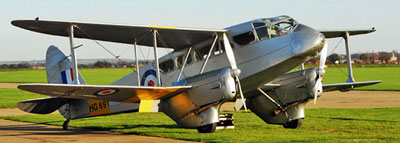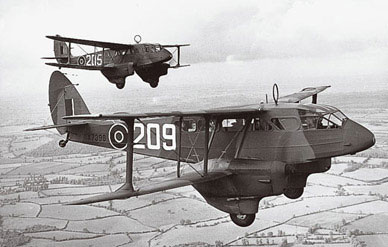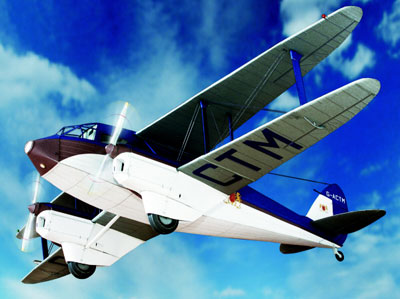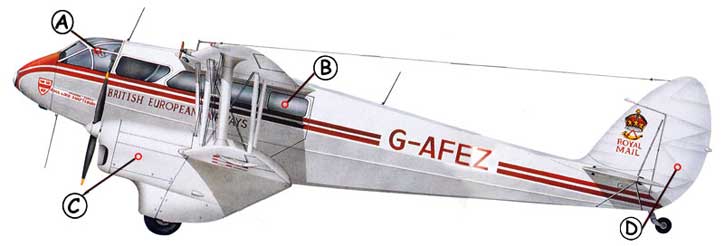de Havilland DH.89 Dragon Rapide

Designed in the 1930s the de Havilland DH.89 Dragon Rapide was one of many reasonably successful light commercial transports of the ear. But the outbreak of war was to see production soar to keep pace with demand for communications and navigation trainers. After the war, hundreds of ex-service aircraft came onto the market, and the faithful old biplane was to become an important part of the post war boom in commercial aviation, flying in a multitude of roles from scheduled airliner to fun flier.
de Havilland DH.89
 The de Havilland Aircraft Company
was probably more closely associated
with the expansion of British civil
aviation in the 1930s than any other
manufacturer in Britain, and throughout this period de Havilland produced
a succession of exceptional light
aircraft.
The de Havilland Aircraft Company
was probably more closely associated
with the expansion of British civil
aviation in the 1930s than any other
manufacturer in Britain, and throughout this period de Havilland produced
a succession of exceptional light
aircraft.
Perhaps the most famous was the
D.H.82 Tiger Moth. A total of 8,300 of
these small biplane trainers was built
and the Royal Air Force used the Tiger
Moth as a basic trainer for fifteen
years; many are still being flown from
small airfields all over the world as they
are still a favorite with private owners.
The D.H.60 Moth of 1925 was the
forerunner of the Tiger Moth. More
than 1,700 D.H.60s were built, of
which some 1,100 used the Gipsy
engine designed and built by the de
Havilland company itself. The simplicity, resilience. safety and low cost of
this engine were to make it one of the
main lessons for the Tiger Moth's
success. The Tiger Moth made its
maiden flight on 26 October 1931, and
large-scale production began almost
immediately, mostly for the Royal Air
Force. In 1947 the R.A.F. declared the
Tiger Moth obsolete and thousands of
these small biplanes suddenly came on
to the civil market, where they were
bought by private pilots and flying
clubs and were given a second lease of
life. 
After the success of several de Havilland single-engine types, the company turned once more to the construction of a larger aircraft. The D.H.84 Dragon prototype first flew in 1932 and was the first of a series of famous multi-engine aircraft. The D.H.84 was a twin-engine. six- passenger biplane which had been specially ordered from de Havilland for use as a commercial transport on the Paris route. The Dragon was an instant success and de Havilland manufactured a total of 115 which were bought by numerous sma1l air- lines. Much larger than the Dragon, the D.H.86 took to the air on 14 January 1934. The aircraft had been developed for the Australian sector of the England-Australia route and was to be operated by Qantas between Singapore and Brisbane. It was a four- engine development of the D.H.84, which proved very reliable, considerably faster and had increased capacity. The production run totaled 62 and included 20 D.H.86As and 10 D.H.86Bs built in 1936-37 which had modified fuselages and strengthened tail surfaces. The D.H.86 started its career on 20 August 1934, with Railway Air Services and was used for many years in Europe, Africa, the Middle and Far East. New Zealand and, of course, Australia, in the livery of various airlines.
The last of this series was the D.H.89 Dragon Rapide, the prototype of which first flew on 17 April 1934. This aircraft was, in essence, an updating of the twin-engine D.H.84 with more powerful engines and improved performance. More than 700 were built during the course of over ten years and they were even more successful immediately after World War II, when many aircraft of the military variant, the Dominie, built for the R.A.F., came on to the civil market. A few Dragon Rapides are still flying in various parts of the world.

De Havilland's last civil transport
aircraft before the outbreak of war was
the D.H.95 Flamingo, a modern all-
metal twin-engine monoplane, the
prototype of which first flew on 28
December 1938. The fact that it was of
al1-meta1 construction represented a
new departure from de Havilland's
well-known tradition of specializing in
wooden construction. Sixteen Flamingoes were manufactured, the prototype was operated by Jersey Airways in
I 939, and others saw service during the
war with BOAC in Africa and the
Middle East, and with the Royal Navy.

Wood-Frame and Fabric-Skin Airliner

The DH.89 was a twin-engined development of the high-performance DH.86 Dragon. First flown in April 1934, its reliability and economy proved popular with small airlines. Officially called the Dragon Rapide, but known to most of its users simply as the Rapide, it was soon in worldwide use with operators from the tropics to high Arctic, and by the outbreak of war more than 200 had been built.
World War II increased demand for the aircraft, and 521 were completed and de Havilland Dominie navigation trainers. After the war, several hundred surplus machines were supplied to overseas air forces and, stripped of military equipment, to civil buyers.
After the war, Rapides could be found working for major government and commercial organizations, small charter airlines and air taxi companies. They shipped freight to the South American interior, flew business executives to important meetings around Europe, took tourists on pleasure trips over the Florida Everglades, and maintained island-hopping commercial services in areas as diverse as Scotland's outer isles and the volcanic chains of French Polynesia.


Specifications for the de Havilland Dragon-Rapide
 |
Crew: 1
|
 |
The cockpit of the DH.89 had only the basic instruments. |
 |
|
| A: Rapides were driven by two-blade fixed-pitch wooden propellers. | B: The main structure of the Dragon Rapide was a spruce and birch framework with light alloy and fabric skin. |
 |
|||
| A: Cockpit configuration generally sat a single pilot, with basic instruments and controls. | B: The cabin held up to eight passengers, seated in pairs. | C: The Dragons and Rapides used Gipsy Six and Gipsy Major engines. | D: The curved tail of the Rapide was a classic de Havilland feature. |

